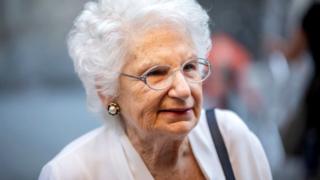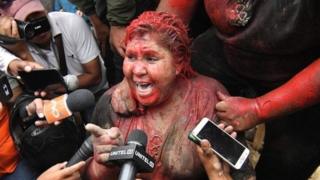 Image copyright
Image copyright
Sanjana Nagesh
Sanjana Nagesh believes it’s time for “brown girls” to rise up and take ownership of their identities
There’s a sisterhood emerging on Instagram and it’s one made up of young women from around the globe who proudly identify as “brown girls” – but just who are they and what is it that they want?
“We’re told that ‘we’re too brown’ or ‘we’re not brown enough’ but Instagram is now giving us an opportunity to take back our culture and play with it – and that’s exactly what we are doing”, states Sanjana Nagesh, the founder of BrownGirlGang.
And with 50,000 followers on her Instagram site alone who are hungry for content created by and for “brown girls”, it’s clear this Australian has tapped into a growing market.
Image copyright
Getty Images
Comedian Mindy Kaling is often cited as an inspiration by South Asian women
“I was scrolling through Instagram and kept discovering women like me doing amazing things, together with a lot of fusion going on where our rich South Asian heritage is being mixed with common pop culture – leading to some amazing creativity. I wanted to show that off.”
A quick glance at her curated database, which attracts followers from the US, India, Canada and the UK, shows memes relating to actress Mindy Kaling, activist Jameela Jamil, as well as numerous Bollywood stars. It also has pictures of emerging artists, entrepreneurs and content creators – all of whom have the quality of being a “brown girl” in common.
Artists such as Simmi Patel, the creator of @paper.samosa and Neha Gaonkar of @thecutepista are among those highlighted on Sanjana’s page as brown girls whose observations about life are worth keeping an eye on.
Image copyright
Simmi Patel
Simmi Patel uses Instagram to showcase South Asian culture
Simmi, an advertising copywriter, was born in the UK before moving to the US as a child. She taps into her Gujarati Kenyan Indian heritage for inspiration for the memes referencing a mishmash of Indian and western pop culture which she posts on Paper Samosa.
“I wanted to create something cool but that was different and would speak to people like me. It needed to be something that tapped into this mixture of eastern and western culture that the young desi generation has access to. We’re interested in pop culture and mixing up everything that’s modern with our traditions.”
The term “desi” Simmi uses is derived from the Sanskrit word “desha”, meaning country or land, is used to refer to those of South Asian heritage who live abroad – the diaspora.
And with hundreds of thousands of uses of the term #BrownGirl and its plural respectively, and more than 5.8 million uses of the desi hashtag on Instagram, it looks like this is a group that’s here to stay.
Image copyright
Simmi Patel
Simmi wants to bring a smile to people’s faces with her art which includes this image highlighting the fact that chai and tea mean the same thing
“Before you had to rely on movies and television and women like us would be represented by one-dimensional characters and an amalgamation of cliches. Not any longer. We’re presenting our own narratives,” says Sanjana.
Professor Radhika Gajjala of Bowling Green State University in Ohio, is researching how South Asians use digital media. She is not surprised by the brown girl movement.
Bollywood stars have been using the media for a long time to show off a particular controlled image, one very much focused on their brands, she says.
“These young women, who are digitally native, are expressing themselves in a similar but more authentic way. In fact, you are now seeing Bollywood stars see the success of these women and take inspiration from it – so posting candid shots and ones that fit less of a formula.”
These are the children and grandchildren of immigrants who want to connect with their roots of their culture but also show how they are very much part of popular millennial culture, she adds. These women are part of what I call the digital diaspora.”
Image copyright
Neha Gaonkar
Neha Gaonkar is an architect for her day job but uses Instagram as a creative outlet
It’s something trainee architect, and the brains behind The Cute Pista account, Neha Gaonkar agrees with.
“I grew up in India and the UK and I moved to Chicago in the US about 10 years ago. It’s about trying to find a happy medium with such a rich mix of culture and immigration and travel in our heritage. It’s about trying to find out where we fit in.”
She says that more recently she’s been wanting to immerse herself in the roots of her Indian culture and turned to Instagram where she found others highlighting relatable content.
“I came across so many amazing talented people who were showing what it’s like to be Indian, Pakistani and much more. I was getting exposed to this whole rich history and I wanted to be part of it”.
Image copyright
Neha Gaonkar
The use of multilingual puns makes accounts like Neha’s very popular
Pranavi Suthagar, from Toronto, says she is also proud to identify as a brown girl.
She is Tamil-Canadian and a graphic designer by trade.
She also runs the Not Sari Instagram account where she posts prints and highlights clothes and badges she’s made. She says her work attempts to “decode the brown experience one illustration or collage at a time.”
She adds: “When I was growing up I’d make friends with other brown people. We had incredibly different backgrounds and came from different countries but there were so many similarities in the way we were brought up and the experiences we shared. I love that we could bond over these cultural norms.”
Image copyright
Pranavi Suthagar
Pranavi Suthagar is proud to be a brown girl
Prof Gajjala adds the use of the word brown was significant as it was a term that helped people from a variety of backgrounds to “bridge” their different histories but also show what they had in common.
“It’s not just about South Asian women; it includes those people with a rich history of immigration in their families – whether deliberate or forced because of colonisation and indentured slavery and more. They have ‘being brown’ in common.”
She says “brown”, as an identity, became more visible after the terror attacks in the US on 11 September 2001.
“It was about political convergence; this word brought people from different backgrounds together. They were being looked upon as ‘the other’ and this word erased the differences in history between these people who had always been looked upon as migrants.”
She adds: “Brown is not a racial category – there is no census document that says that. But brown has always been viewed as migrant – especially here in the US. Now we are seeing women especially using brown to mobilise and take ownership of their narratives.”
Now with social media, these women are finding each other. They may come from different backgrounds, live across borders but are discovering they have much in common.
Pranavi says: “Brown is a colloquial term. I’m a brown person. It’s helpful for people who don’t want to use the word ‘desi’ as it’s more inclusive. It can include people who are from Indo-Caribbean backgrounds or Sri Lankan or mixed or much more. It’s a great term.
“I don’t think white people would use it but I wouldn’t personally be offended if they did. In my experience it’s not a derogatory word and it’s never been used that way towards me by anyone; it’s a cool term.”
She said that the traditional image of a South Asian woman was of someone who was protected, oppressed and traditional. But many of the brown girls on Instagram were joining her in subverting that and often using humour – in different ways – to show that they are playful but they are fighting back.
“These brown women don’t need white saviours,” she adds.
But what about those who have been using social media for a while to highlight desi culture? What do they think about this zeitgeist moment?
Maria Qamar, who is behind HateCopy account, is often cited as an inspiration by upcoming desi artists. An artist who began on social platforms, she’s now had her work shown globally, has been championed by Mindy Kaling, and is currently exhibiting in New York.
As Simmi says, “It’s Hatecopy who put desi aunties on the map.”
Maria, who lives in Toronto, Canada, says: “A lot of my work is made in isolation so it’s amazing that people can relate to it. I used to think the experiences I had were personal to me but that’s clearly not the case.”
She adds: “What’s happening now is that women are taking ideas of dated tradition designed to keep us in line and keep us down and combating that. Desi women are coming out and saying ‘ I will do what I want to do”.
Maria shrugged off concerns that the brown girl label could be limiting, saying: “I’m a brown girl. That’s what I am. It’s the lens through which we are working.
“Brown girls are pro-us; not anti-you. We should be allowed to celebrate – especially as women of colour are the least represented in the media. Black and brown women are often pushed to the side.
“Now we are being seen and on our terms.”












